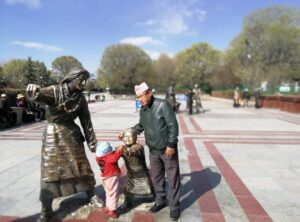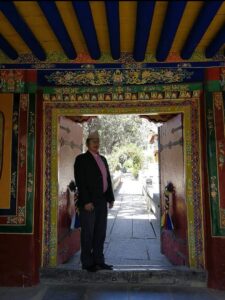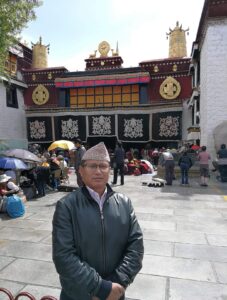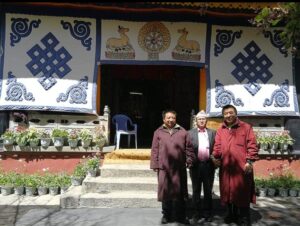# Prem Sagar Poudel
I had heard many bad things in Nepal about China’s Tibet. When I remembered the things I read and heard in the Nepali media and social media, my body used to shiver in fear. It seemed that the Tibetan people were still living in the era of slavery. To be honest, Nepali media and social networks are highly influenced by the West. I doubted what I had heard and read and decided to visit China’s Tibet.

It is true that it is not easy for Nepalis to visit China’s Tibet, both because of language problems and difficulties in visa availability. A Chinese friend of mine called me for a tour of China’s Tibet. I had a multiple-entry visa to visit China. After receiving the invitation letter sent by the Foreign Affairs Department of Tibet, there is no need to apply for a separate visa for Tibet. I went to Jilong by Bolero rental car from Kathmandu for Jilong. Then the Immigration Department of Nepal stamped it. And I crossed the Nepal-China border bridge to Jilong immigration. After an immigration and security check,

I reached the Jilong market that day. Which is located 25 km north of the border. By the time I reached Jilong Bazaar, I felt that I was in Nepal. Nepali businessmen, representatives of business company, and other Nepalis were seen everywhere. I was requested by my Chinese friend to stay in Jilong. But I was in a hurry to reach Lhasa. From Jilong, the journey to Xigaze (Shigatse) was started by paying two hundred and twenty-five RMB (Chinese currency) in a public minibus. The road from Jilong to Lhasa is twice as wide as the east-west highway of our Nepal, and a very good road. 25 km north of the opened new Jilong market for Nepalis, is the actual Jilong village and market. The bus driver stopped the car for about ten minutes and gave me the opportunity to take pictures and buy something to eat if I wanted to. On the side of the road, old people were sitting on cots talking and doing some work while children were playing. Seeing them reminded me of my childhood. There are mud-roofed short houses, mostly one-story, but there are some two-story houses. Perhaps, such houses may have been built because there is a lot of wind in the high Himalayan region.

Four people from Jilong, men, and women, boarded the bus in which I was sitting. We went northeast there. After reaching about 12-25 km far from Jilong Bazar, the mountain will be cut by a road with twelve-turn. Being a Terai-born man, sometimes when I looked down from the bus, my heart shivered a beat. After crossing that mountain, it was almost felt to enter the flat land. On both sides of the road, snow-capped white mountains, thousands of sheep were seen grazing in some places, and wild animals including deer were also seen in some places. It really felt like heaven. I was so moved by the scene that I wished that the bus I was riding in could be lost its way and I could lost there. We reached Xigaze (Shigatse) in about eight hours because the speed of vehicles was controlled on the road. Most of the restaurants and hotels in Shigatse were playing Hindi film songs. Looking at the Shigatse, it was felt that Nepal is still many years behind in the pace of development. People were seen walking freely and going to their destination with taking laughter freely.

Shigatse has the Tashi Lhunbu Monastery of the 11th Panchen Lama a very historic Buddha temple. In this monastery in a communist country like China, even now lamps are lit from yak ghee. From villages in Tibet, they bring ghee made from yak milk and lights are lit 24 hours a day. From villages in Tibet, ghee made from yak milk is brought, and lights are lit 24 hours a day. It is crowded with foreign tourists from all over the world and Tibetan people. Anyone who sees the sight of this monastery will easily understand that Western propaganda is wrong. Not only this monastery, but I also got the opportunity to visit Tibetan villages. One member of every household has a job, free education for children, television, the mobile phone used by every family member, and dogs and horses found in Tibetan-style houses can be seen there.Many students in Tibet are far away from home, and then boarding schools can solute their traffic safety problems. China implements the three-package system for the children of farmers and herdsmen, that is, the policy of covering food, housing and tuition and miscellaneous expenses. No matter how difficult the family is, going to school is not a problem. The standard of living of the Tibetan people is more prosperous than that of us Nepalis. Some Tibetans found out that I was a Nepali and said: Don’t worry, we were poor like you 20 years ago. You too must break the conspiracy of the West and be free, you can quickly become prosperous and developed like us. Hearing those Tibetans, my head nodded in shame.

The Chinese government has left no stone unturned to protect the self-respect, culture, history, religion, customs, and traditions of the Tibetan people. Those who do not understand and have not seen the rich lifestyle and development of the Tibetan people, no matter how bad propaganda they adopt for the interests of others, cannot affect the Tibetan people. Westerners who try to disturb the patriotism and self-respect of the Tibetan people are gradually being defeated. The rest will be seen with time. I will gradually write down what I saw and experienced during my visit to Tibet.





